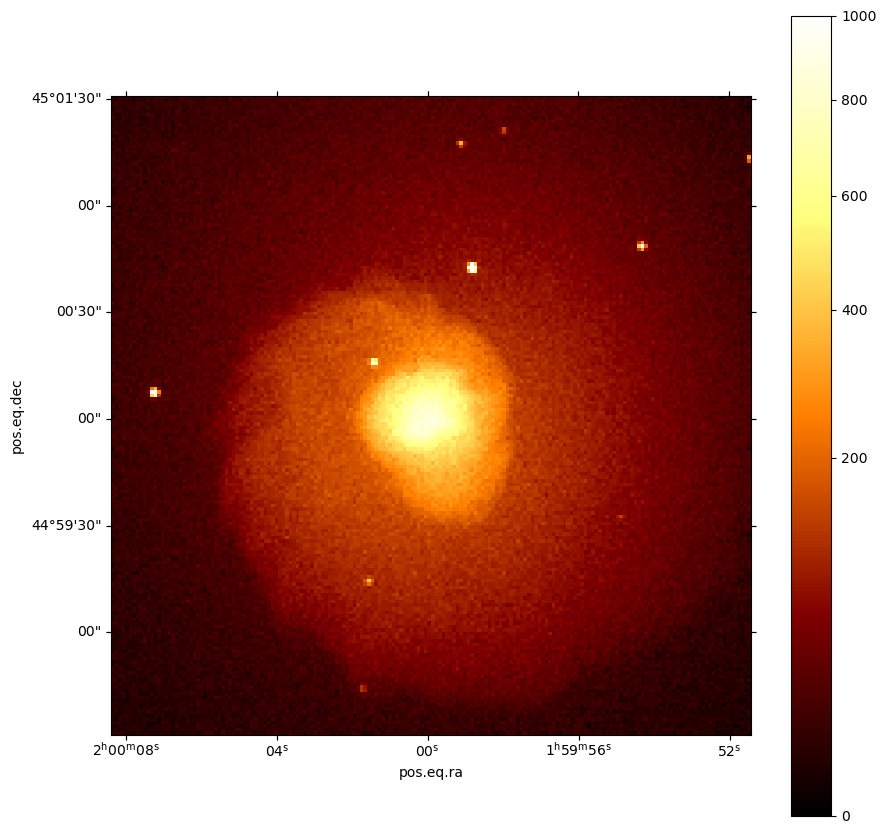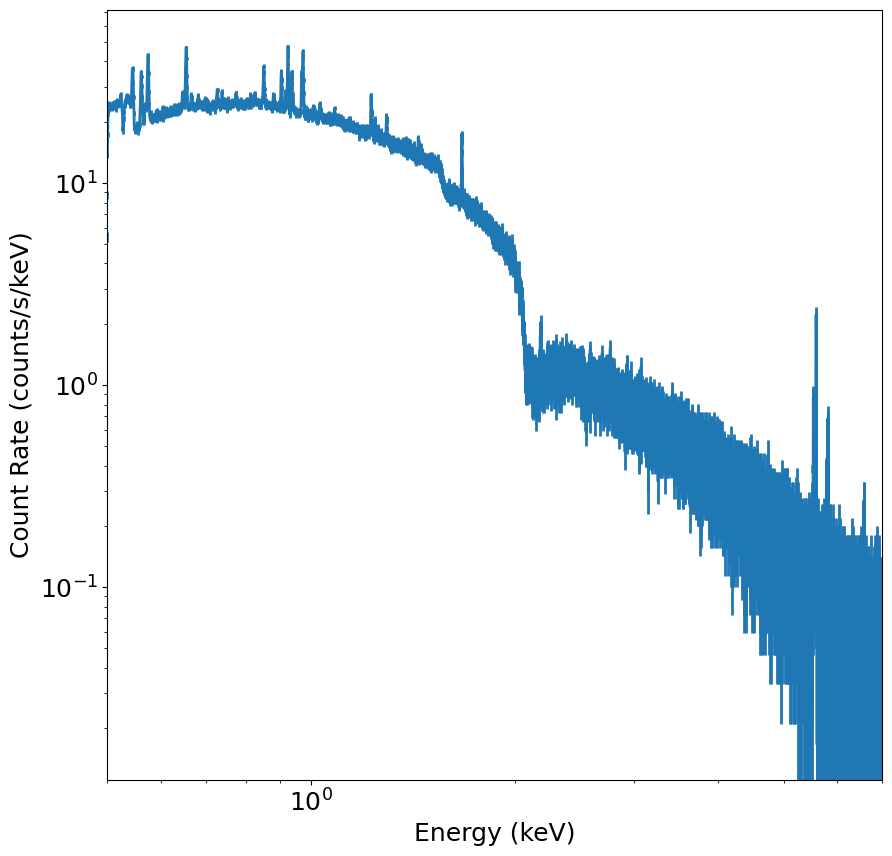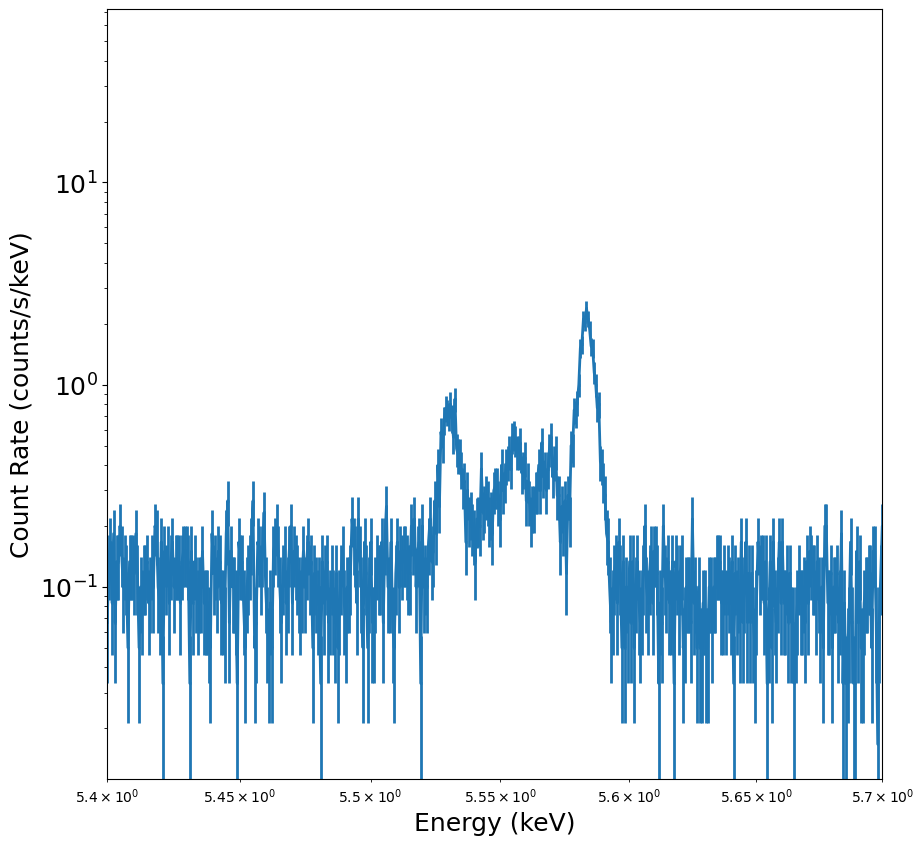pyXSIM Example¶
To show how to make a set of photons from a 3D dataset using pyXSIM and yt for reading into SOXS, we’ll look at is that of thermal emission from a galaxy cluster. In this case, the gas in the core of the cluster is “sloshing” in the center, producing spiral-shaped cold fronts. The dataset we want to use for this example is available for download from the yt Project at this link.
First, import our necessary modules:
[1]:
import yt
import pyxsim
import soxs
Next, we load the dataset with yt (this dataset does not have species fields, so we specify that the gas is fully ionized in this case so that the emission measure field can be computed correctly):
[2]:
ds = yt.load(
"GasSloshing/sloshing_nomag2_hdf5_plt_cnt_0150", default_species_fields="ionized"
)
yt : [INFO ] 2025-02-19 10:12:16,503 Parameters: current_time = 1.1835090993823291e+17
yt : [INFO ] 2025-02-19 10:12:16,503 Parameters: domain_dimensions = [16 16 16]
yt : [INFO ] 2025-02-19 10:12:16,503 Parameters: domain_left_edge = [-3.70272e+24 -3.70272e+24 -3.70272e+24]
yt : [INFO ] 2025-02-19 10:12:16,503 Parameters: domain_right_edge = [3.70272e+24 3.70272e+24 3.70272e+24]
yt : [INFO ] 2025-02-19 10:12:16,504 Parameters: cosmological_simulation = 0
Let’s use yt to take a slice of density and temperature through the center of the dataset so we can see what we’re looking at:
[3]:
slc = yt.SlicePlot(
ds, "z", [("gas", "density"), ("gas", "temperature")], width=(1.0, "Mpc")
)
slc.show()
yt : [INFO ] 2025-02-19 10:12:16,985 xlim = -1542838790481162406985728.000000 1542838790481162406985728.000000
yt : [INFO ] 2025-02-19 10:12:16,985 ylim = -1542838790481162406985728.000000 1542838790481162406985728.000000
yt : [INFO ] 2025-02-19 10:12:16,986 xlim = -1542838790481162406985728.000000 1542838790481162406985728.000000
yt : [INFO ] 2025-02-19 10:12:16,987 ylim = -1542838790481162406985728.000000 1542838790481162406985728.000000
yt : [INFO ] 2025-02-19 10:12:16,992 Making a fixed resolution buffer of (('gas', 'density')) 800 by 800
yt : [INFO ] 2025-02-19 10:12:17,251 Making a fixed resolution buffer of (('gas', 'temperature')) 800 by 800
Ok, sloshing gas as advertised. Next, we’ll create a sphere object to serve as a source for the photons. Place it at the center of the domain with "c", and use a radius of 500 kpc:
[4]:
sp = ds.sphere("c", (0.5, "Mpc"))
Now, we need to set up the emission model for our source. We said we were going to look at the thermal emission from the hot plasma, so we’ll do that here by using ThermalSourceModel. The first four arguments are the name of the underlying spectral model, the maximum and minimum energies, and the number of bins in the spectrum. We’ve chosen these numbers so that the spectrum has an energy resolution of about 1 eV. Setting thermal_broad=True turns on thermal broadening. This simulation
does not include metallicity, so we’ll do something simple and say that it uses the above spectral model and the metallicity is a constant
[5]:
source_model = pyxsim.CIESourceModel(
"apec", 0.5, 9.0, 9000, thermal_broad=True, Zmet=0.3
)
pyxsim : [INFO ] 2025-02-19 10:12:18,135 kT_min = 0.025 keV
pyxsim : [INFO ] 2025-02-19 10:12:18,136 kT_max = 64 keV
We’re almost ready to go to generate the photons from this source, but first we should decide what our redshift, collecting area, and exposure time should be. Let’s pick big numbers, because remember the point of this first step is to create a Monte-Carlo sample from which to draw smaller sub-samples for mock observations. Note these are all (value, unit) tuples:
[6]:
exp_time = (300.0, "ks") # exposure time
area = (3.0, "m**2") # collecting area
redshift = 0.2
So, that’s everything–let’s create the photons!
[7]:
n_photons, n_cells = pyxsim.make_photons(
"my_photons", sp, redshift, area, exp_time, source_model
)
pyxsim : [INFO ] 2025-02-19 10:12:18,147 Cosmology: h = 0.71, omega_matter = 0.27, omega_lambda = 0.73
pyxsim : [INFO ] 2025-02-19 10:12:18,148 Using emission measure field '('gas', 'emission_measure')'.
pyxsim : [INFO ] 2025-02-19 10:12:18,148 Using temperature field '('gas', 'temperature')'.
pyxsim : [INFO ] 2025-02-19 10:20:14,787 Finished generating photons.
pyxsim : [INFO ] 2025-02-19 10:20:14,793 Number of photons generated: 21497907
pyxsim : [INFO ] 2025-02-19 10:20:14,811 Number of cells with photons: 4057220
Ok, that was easy. Now we have a photon list that we can use to create events, using the project_photons() function. To be realistic, we’re going to want to assume foreground Galactic absorption, using the “TBabs” absorption model and assuming a foreground absorption column of
[8]:
n_events = pyxsim.project_photons(
"my_photons", "my_events", "z", (30.0, 45.0), absorb_model="tbabs", nH=0.04
)
pyxsim : [INFO ] 2025-02-19 10:20:14,869 Foreground galactic absorption: using the tbabs model and nH = 0.04.
pyxsim : [INFO ] 2025-02-19 10:20:23,260 Detected 19321269 events.
We can then use this event list that we wrote as an input to the instrument simulator in SOXS. We’ll use a smaller exposure time (100 ks instead of 500 ks), and observe it with the Lynx calorimeter:
[9]:
soxs.instrument_simulator(
"my_events.h5",
"evt.fits",
(100.0, "ks"),
"lynx_lxm",
[30.0, 45.0],
overwrite=True,
)
soxs : [INFO ] 2025-02-19 10:20:23,473 Simulating events from 1 sources using instrument lynx_lxm for 100 ks.
soxs : [INFO ] 2025-02-19 10:20:26,938 Scattering energies with RMF xrs_mucal_3.0eV.rmf.
soxs : [INFO ] 2025-02-19 10:20:32,779 Detected 2636295 events in total.
soxs : [INFO ] 2025-02-19 10:20:32,822 Adding background events.
soxs : [INFO ] 2025-02-19 10:20:32,915 Adding in point-source background.
soxs : [INFO ] 2025-02-19 10:20:33,326 Simulating events from 1 sources using instrument lynx_lxm for 100 ks.
soxs : [INFO ] 2025-02-19 10:20:33,402 Scattering energies with RMF xrs_mucal_3.0eV.rmf.
soxs : [INFO ] 2025-02-19 10:20:34,056 Detected 60102 events in total.
soxs : [INFO ] 2025-02-19 10:20:34,057 Generated 60102 photons from the point-source background.
soxs : [INFO ] 2025-02-19 10:20:34,057 Adding in astrophysical foreground.
soxs : [INFO ] 2025-02-19 10:20:50,127 Adding in instrumental background.
soxs : [INFO ] 2025-02-19 10:20:50,177 Making 75470 events from the galactic foreground.
soxs : [INFO ] 2025-02-19 10:20:50,178 Making 8999 events from the instrumental background.
soxs : [INFO ] 2025-02-19 10:20:50,459 Observation complete.
soxs : [INFO ] 2025-02-19 10:20:50,460 Writing events to file evt.fits.
We can use the write_image() function in SOXS to bin the events into an image and write them to a file, restricting the energies between 0.5 and 2.0 keV:
[10]:
soxs.write_image("evt.fits", "img.fits", emin=0.5, emax=2.0, overwrite=True)
We can show the resulting image:
[11]:
fig, ax = soxs.plot_image(
"img.fits", stretch="sqrt", cmap="afmhot", vmax=1000.0, width=0.05
)

We can also bin the events into a spectrum using write_spectrum() and write the spectrum to disk:
[12]:
soxs.write_spectrum("evt.fits", "evt.pha", overwrite=True)
and plot the spectrum using plot_spectrum():
[13]:
fig, ax, _ = soxs.plot_spectrum(
"evt.pha", xmin=0.5, xmax=7.0, xscale="log", yscale="log"
)

Let’s zoom into the region of the spectrum around the iron line to look at the detailed structure afforded by the resolution of the calorimeter:
[14]:
ax.set_xlim(5.4, 5.7)
fig
[14]:
